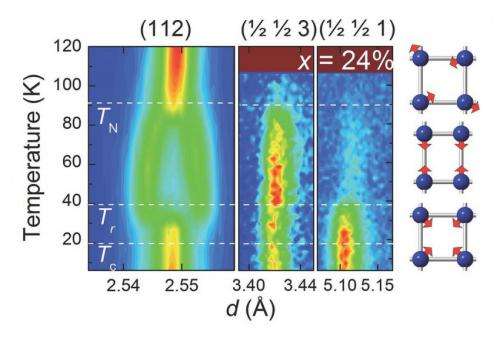Scientists discover new magnetic phase in iron-based superconductors

(Phys.org) —Scientists at the U.S. Department of Energy's Argonne National Laboratory have discovered a previously unknown phase in a class of superconductors called iron arsenides. This sheds light on a debate over the interactions between atoms and electrons that are responsible for their unusual superconductivity.
"This new magnetic phase, which has never been observed before, could have significant implications for our understanding of unconventional superconductivity," said Ray Osborn, an Argonne physicist and coauthor on the paper.
Scientists and engineers are fascinated with superconductors because they are capable of carrying electric current without any resistance. This is unique among all conductors: even good ones, like the copper wires used in most power cords, lose energy along the way.
Why don't we use superconductors for every power line in the country, then? Their biggest drawback is that they must be cooled to very, very cold temperatures to work. Also, we do not fully understand how the newest types, called unconventional superconductors, work. Researchers hope that by figuring out the theory behind these superconductors, we could raise the temperature at which they work and harness their power for a wide range of new technologies.
The theory behind older, "conventional" superconductors is fairly well understood. Pairs of electrons, which normally repel each other, instead bind together by distorting the atoms around them and help each other travel through the metal. (In a plain old conductor, these electrons bounce off the atoms, producing heat). In "unconventional" superconductors, the electrons still form pairs, but we don't know what binds them together.
Superconductors are notably finicky; in order to get to the superconducting phase—where electricity flows freely—they need a lot of coddling. The iron arsenides the researchers studied are normally magnetic, but as you add sodium to the mix, the magnetism is suppressed and the materials eventually become superconducting below roughly -400 degrees Fahrenheit.
Magnetic order also affects the atomic structure. At room temperature, the iron atoms sit on a square lattice, which has four-fold symmetry, but when cooled below the magnetic transition temperature, they distort to form a rectangular lattice, with only two-fold symmetry. This is sometimes called "nematic order." It was thought that this nematic order persists until the material becomes superconducting—until this result.
The Argonne team discovered a phase where the material returns to four-fold symmetry, rather than two-fold, close to the onset of superconductivity. (See diagram).
"It is visible using neutron powder diffraction, which is exquisitely sensitive, but which you can only perform at this resolution in a very few places in the world," Osborn said. Neutron powder diffraction reveals both the locations of the atoms and the directions of their microscopic magnetic moments.
The reason why the discovery of the new phase is interesting is that it may help to resolve a long-standing debate about the origin of nematic order. Theorists have been arguing whether it is caused by magnetism or by orbital ordering.
The orbital explanation posits that electrons like to sit in particular d orbitals, driving the lattice into the nematic phase. Magnetic models, on the other hand (developed by study co-authors Ilya Eremin and Andrey Chubukov at the Institut für Theoretische Physik in Germany and the University of Wisconsin-Madison, respectively) suggest that magnetic interactions are what drive the two-fold symmetry—and that they are the key to the superconductivity itself. Perhaps what binds the pairs of electrons together in iron arsenide superconductors is magnetism.
"Orbital theories do not predict a return to four-fold symmetry at this point," Osborn said, "but magnetic models do."
"So far, this effect has only been observed experimentally in these sodium-doped compounds," he said, "but we believe it provides evidence for a magnetic explanation of nematic order in the iron arsenides in general."
It could also affect our understanding of superconductivity in other types of superconductors, such as the copper oxides, where nematic distortions have also been seen, Osborn said.
More information: "Magnetically driven suppression of nematic order in an iron-based superconductor." S. Avci, et al. Nature Communications 5, Article number: 3845 DOI: 10.1038/ncomms4845. Received 10 March 2013 Accepted 08 April 2014 Published 22 May 2014
Journal information: Nature Communications
Provided by Argonne National Laboratory




















